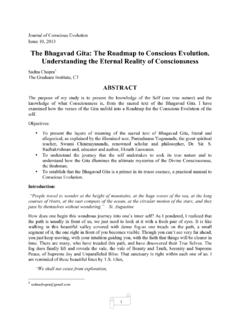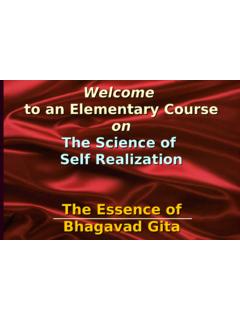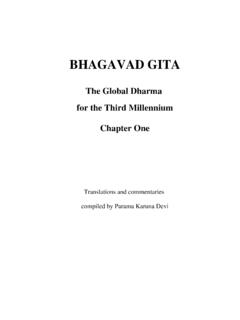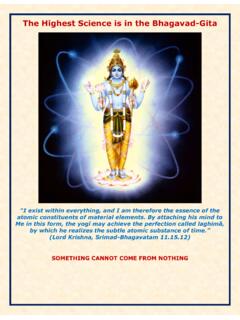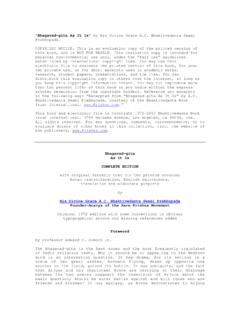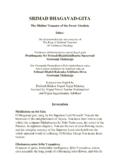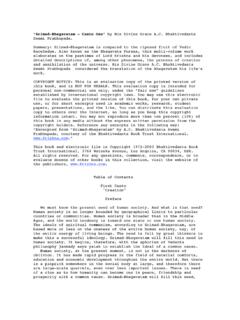Transcription of Srimad-Bhagavad-Gita, English translation and commentary ...
1 srimad - bhagavad -Gita, English translation and commentary by Swami Swarupananda, [1909], at srimad - bhagavad -GITA By SWAMI SWARUPANANDA ADVAITA ASHRAMA Mayavati, Almora, Himalayas [1909] Scanned, Proofed and formatted by John Bruno Hare at , March 2008. This text is in the public domain in the US because it was published prior to 1923. srimad - bhagavad -Gita, English translation and commentary by Swami Swarupananda, [1909], at [] PREFACE TO THE FIRST EDITION Swami Swarupananda, the first president of the Advaita Ashrama, Mayavati, and late editor of the Prabuddha Bharata, compiled the present edition of the bhagavad -Gita with the collaboration of his brother Sannyasins at Mayavati, and some of the Western disciples of Swami Vivekananda.
2 The manuscripts were begun in 1901, and were ready for the Press by the end of 1903, but through unavoidable circumstances the publication was delayed. It was only after the passing away of Swami Swarupananda that the work was brought out in monthly instalments in the Prabuddha Bharata, and this work is now presented to the public in convenient book form, after being carefully edited and enlarged with additional comments. The object of the compiler was to make accessible to the Indian public who are educated in English but have a limited knowledge in Sanskrit, and also to the Western world, an edition of the Celestial Gita, in which they will feel sufficient interest to follow the original text, and thus create a taste for the study and interpretation of holy Sanskrit literature.
3 How far the compiler has been successful in his object can be gleaned from the following pages. His thoughtful comments following the commentaries of the great Acharyas, and illuminating [] sidelights thrown on intricate places, will, we trust, be of much help to the study of the Gita, especially to a beginner. An elaborate Index has been subsequently added. A word of explanation as to the paraphrase is necessary here: Though the literal meaning of each word is given, yet to avoid the awkwardness of language and confusion of sense to a beginner, the equivalents of case terminals of such words as are used to qualify some other words in the sentence, are omitted in most cases. We hope this edition will meet a much-felt want, not only in India but in all English -speaking countries.
4 THE EDITORS AND PUBLISHERS ADVAITA ASHRAMA MAYAVATI, HIMALAYAS 18th October, 1909 srimad - bhagavad -Gita, English translation and commentary by Swami Swarupananda, [1909], at [] CONTENTS PAGE FOREWORD <page i> MEDITATION <page v> INVOCATION <page xii> CHAPTER I. THE GRIEF OF ARJUNA <page 1> II. THE WAY OF KNOWLEDGE <page 27> III. THE WAY OF ACTION <page 72> IV. THE WAY OF RENUNCIATION OF ACTION IN KNOWLEDGE <page 96> V.
5 THE WAY OF RENUNCIATION <page 120> VI. THE WAY OF MEDITATION <page 137> VII. THE WAY OF KNOWLEDGE WITH REALISATION <page 163> VIII. THE WAY TO THE IMPERISHABLE BRAHMAN <page 179> IX. THE WAY OF THE KINGLY KNOWLEDGE AND THE KINGLY SECRET <page 197> X. THE GLIMPSES OF THE DIVINE GLORY <page 219> XI. THE VISION OF THE UNIVERSAL FORM <page 241> XII. THE WAY OF DEVOTION <page 276> XIII. THE DISCRIMINATION OF THE KSHETRA AND THE KSHETRAJNA <page 288> PAGE XIV.
6 THE DISCRIMINATION OF THE THREE GUNAS <page 308> XV. THE WAY TO THE SUPREME SPIRIT <page 323> XVI. THE CLASSIFICATION OF THE DIVINE AND THE NON-DIVINE ATTRIBUTES <page 337> XVII. THE ENQUIRY INTO THE THREEFOLD SHRADDHA <page 349> XVIII. THE WAY OF LIBERATION IN RENUNCIATION <page 364> THE GREATNESS OF THE GITA <page 406> INDEX <page 435> srimad - bhagavad -Gita, English translation and commentary by Swami Swarupananda, [1909], at [p. i] FOREWORD THE srimad - bhagavad -Gita occurs in the Bhishma Parva of the Mahabharata and comprises 18 chapters from the 25th to the 42nd.
7 The discourse between Arjuna and Krishna on the battle-field, on the eve of the war which forms the subject-matter of the work, was strung together in seven hundred verses and put in its place in the body of his great history by Vyasa. The Gita opens with Dhritarashtra's query to Sanjaya about the progress of events. In the second chapter of the Bhishma Parva, we find Vyasa offering the power of sight to the blind king, that he might see the war. Dhritarashtra declined to have it, saying he did not care to have eyes with which only to see the death of his own people; but he would like to hear what was happening. On this the great Rishi Vyasa said, that all the occurrences in connection with the war would be reflected in the mind of Sanjaya, and he would faithfully report them to Dhritarashtra.
8 The Gita is called an Upanishad, because it contains the essence of Self-knowledge, and because its teachings, like those of the Vedas, are divided into three sections, Karma (work), Upasana (devotion) and Jnana (knowledge). [p. ii] The first chapter is introductory. The second is a summary of the whole work, , in II. 48 and the connected Slokas, self-less work devoid of desire for fruits, is taught for the purification of the heart; in II. 61 and the connected Slokas devotion is taught to the pure-hearted, to qualify them further for the highest Sannyasa, which last is taught in II. 71 and the connected Slokas. It is also usual to divide the work into three sections illustrative of the three terms of the Mahavakya of the Sama-Veda, "Thou art That" (Chhand.)
9 Upa., VI. viii. 7). In this view the first six chapters explain the path of work without desire for fruits, and the nature of "Thou." The next six chapters deal with devotion and the nature of "That." The last six describe the state of the highest knowledge and the nature of the middle term of the Mahavakya, in other words, the means of re-establishing the identity of "Thou" and "That." The central teaching of the Gita is the attainment of Freedom, by the performance of one's Swadharma or duty in life. "Do thy duty without an eye to the results thereof. Thus shouldst thou gain the purification of heart which is essential for Moksha,"--seems to be the keynote of Krishna's teachings to Arjuna.
10 It is well known why the Gita came into existence. It was owing to Arjuna's unwillingness to do his duty as a Kshatriya--to fight for a just [p. iii] cause--because it involved the destruction of his own people. Not that Arjuna did not recognise the justice and right of the cause, but he would rather renounce the world and try for Moksha than kill his relatives and friends. Krishna's characterisation of this weakly sentimental attitude of Arjuna is well known. He called it "Un-Arya-like delusion, contrary to the attainment alike of heaven and honour" and exhorted Partha to "yield not to unmanliness" but to "cast off this mean faintheartedness." (II. 2-3). "Could a coward who fails to do his duty, be worthy to attain Moksha?

